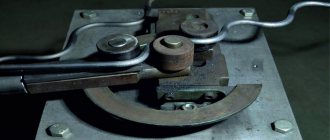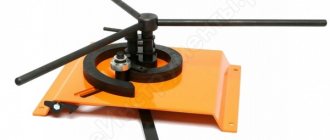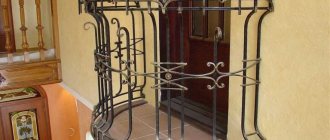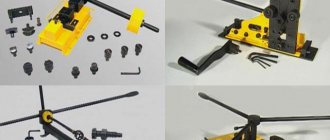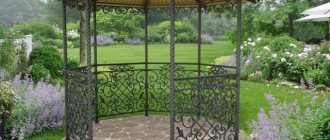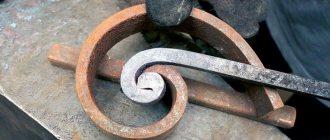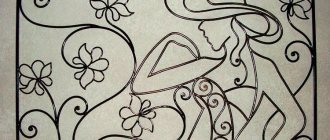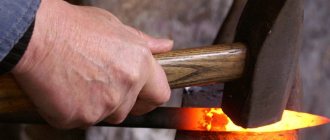People have been processing metal for thousands of years. There are two main processing technologies known: hot and cold forging. The first method requires the use of heating equipment to melt or heat the metal. The second technology is performed using special equipment. Cold forging machines are simple designs that you can make yourself.
Cold Forging Machine
Cold forging process
Cold forging is a simple metal processing process. A blacksmith bends parts using hand tools. The work is carried out using levers that reduce the human force transmitted to the material. The resulting products are stronger than those produced by casting. In cold forging, the machine simultaneously bends and presses the workpiece.
Changing the shape of metal parts without heating is used in the manufacture of:
- bars on windows;
- wicker forged fences;
- garden furniture;
- individual elements of the facade;
- lanterns
Equipment for bending metal blanks allows you to create products of various shapes. Complex metal structures are made from individual parts using a welding machine.
How to paint forged products
Forged products can be painted with alkyd, oil, acrylic and nitrocellulose enamels. Each of them has its own pros and cons. Some are more suitable for interior work, others for exterior finishing. In addition to them, there are compositions specially made for painting metal, including forged products.
Hammer paint consists of synthetic resins, silicone, crushed glass, aluminum powder and other components. It is suitable for both internal and external use, it can be applied even to an unprepared rusty surface, during operation it is maximally resistant to any influences, and retains its marketable appearance for about 25 years. Paintwork materials have high aesthetic properties: small potholes form on the dried surface, visually reminiscent of marks from hammer blows.
Forge paint is expensive, but its effectiveness and efficiency exceed the price. The consistency is similar to liquid rubber. High quality and long service life (8 years) of the German forging paint WS-Plast. The WS-Patina composition has a patina effect. Zinga coating protects metal from electrochemical and physical influences and lasts for more than 40 years. All these paints dry no later than 2 hours after application.
Important: It is not recommended to coat cold forged products with nitro paint. It is cheap, but loses its presentation within a year or two after use.
Types of machines
There are different types of forging machines that can be used to change metal workpieces. These are lever-type structures that you can assemble yourself. To do this, you need to understand the principle of operation of individual models.
Snail
This is a manual unit for creating curls and spirals from a metal rod. Homemade snail cold forging machines are present in many workshops. To bend small workpieces, a special cam mechanism is used.
Torsion bar
Cold forging devices used to twist metal rods of different sizes. A blacksmith can bend one rod in a spiral or combine several into one. It is a cast base on which two types of vices are attached. Some are stationary with a collar, others move along the base. The vice is designed to secure rods. Next, the blacksmith twists the gate to the desired position.
To twist several workpieces together, equipment with installed motors is used. Such designs reduce human effort when working with workpieces to a minimum. Mechanized units bend metal parts more efficiently.
Gnutik
This is a manual machine for forging metal. It is considered the main mechanism for bending rods at different angles. The design of a machine for forging metal consists of a metal base on which two fixed shafts are fixed, and a moving part between them. Using a moving element, the blacksmith selects the angle at which the workpiece will be bent.
Gnitik machine
Wave
Manual equipment. Allows you to bend metal workpieces according to the waveform. It is a series of metal disks that are located in one straight line. The distance between them can vary depending on the required wave bends.
Press
To make flat ends on metal products, a homemade press is used. It consists of two disks that are connected to each other by a gear system. The reinforcement is fixed at one end between the disks. The blacksmith starts the rotation using a handle.
Top 10 books on blacksmithing
The book market offers a wide selection of publications on various types of metal processing. A designer, an architect, a novice craftsman, and an experienced blacksmith will find the necessary information in them.
- Forged products in home decoration. Catalog. Publisher: Adelant. On the pages of the publication you can familiarize yourself with the designs of unique stair railings, door and ventilation grilles, and balcony railings.
- Working with metals, plastics and glass. Author: Safronenko V.M. In a book that will be of interest to both professionals and amateurs, the master blacksmith reveals the secrets of making original forged products.
- Secrets of blacksmithing. Authors: Loginov V.P., Bobrova V.V. The pages reveal a large number of trends in artistic forging. The publication harmoniously combines theoretical information with high-quality illustrations.
- Artistic forging. Design. Authors: Guailburt, Vidiella. A book with photographs reveals various trends in the art of metal forging. In the presented works, the reader will become acquainted with the current capricious fashion for blacksmithing art.
- Doors. Gates. Wickets. Author: Levicheva T.V. A practical guide for customers and blacksmiths. The publication focuses on artistic metal forging. The author clearly describes and illustrates all the stages of creating doors, gates and gates.
- Artistic forging and casting in Moscow. Authors: Ledzinsky V.S., Telichko A.A., Zverev A.V. Metal forging has been perfected over centuries. Today it has received a powerful impetus to continue development. In the book, a team of authors shares their knowledge in materials processing.
- Forging. Coinage. Inlay. Enamel. Author: Borisova L.F. A practical guide for young masters. Through the book you can learn various techniques for processing materials. The theory is complemented by detailed diagrams, drawings, illustrations and drawings.
- Balconies. Window. Lattices. Publisher: Niola 21st century. The material is presented at a high professional level. The book demonstrates different styles of artistic forging that will attract the attention of architects and landscape designers.
- Artistic forging and metalworking art. Publisher: M.: Mechanical Engineering. The authors offer readers unique material in a systematized form. The textbook will be of interest to both beginners and experienced professionals.
- Stair railings. Author: Levicheva T.V. The book is about decorative wrought iron stair railings. The material will be of interest to architects, artists, designers and interior decorators who work with metal.
Manufacturing
Assembling homemade machines for cold forging with your own hands does not cause much difficulty. You can make a cold forging machine with your own hands in several stages:
- Prepare drawings. If this is a multifunctional universal machine, diagrams of individual elements can be found on the Internet. Combine them in one drawing, mark the places of fastening and wires. Don't forget to indicate the sizes.
- Prepare tools and consumables. For example, to make a snail you will need a cam mechanism, a spiral made of carbide metal. For a wave you need metal disks, for a torsion bar - a vice.
- The next stage is assembling the structure on which other parts will be attached. To connect metal parts, you must use a welding machine. The seams are cleaned using a grinder and covered with a protective compound.
- Movable elements are fixed to the finished structure, which will interact directly with the workpiece.
- Before you start working, you need to check the reliability of the fastenings.
Despite the variety of drawings and instructions, often the quality of homemade machines leaves much to be desired, and given the amount of time spent, many choose the option of purchasing factory equipment.
Prices for cold forging machines are now at a very low level thanks to the Stancraft company, which has developed and launched into mass sale a universal set of hand-held machines so that any summer resident could afford them.
On their official website stancraft.ru there are such machines as “Snail”, “Torsion + Basket”, “Gnutik”, “Profilebending”. If you want to start working on machines as quickly as possible, the easiest way is to order on the website stancraft.ru.
How to build a curl?
There are plenty of sketches of curls for artistic forging on the Internet, but when you try to adjust their sizes to those required for yourself, it often turns out that the product loses spectacularly due to a seemingly insignificant violation of the proportions. Therefore, it is also desirable to be able to construct forging patterns of curls that obviously have aesthetic advantages.
Templates for cold forging of artistic curls - volutes - are built on the basis of mathematical spirals. The most commonly used is the logarithmic spiral; it is one of the widespread natural forms expressing the fundamental laws of nature. The logarithmic spiral is found in the shell of a snail, in our hearing aids, and in the form of a treble clef in musical notation; in the neck of the violin itself too.
Construction of forming templates for cold forging based on spirals
The principle of constructing a logarithmic spiral by points is that when the radius that forms it is rotated, starting from a certain initial R0, by a fixed angle φ, its length is multiplied by the divergence index of the spiral p. For volutes p, as a rule, take no more than 1.2, because a logarithmic spiral diverges (unwinds) very quickly; on pos. In Fig. a logarithmic spiral with p = 1.25 is shown as an example. To make it easier to build a spiral at points with sufficient accuracy for forging work, take φ = 45 degrees.
In the case when a denser arithmetic spiral is required, when the radius forming it is rotated by the same 45 degrees, 1/8 of the spiral pitch S is added to the previous radius, pos. B. In both cases, R0 is taken equal to or greater than the diameter d of a workpiece of uniform cross-section, pos. A. If the initial end of the workpiece is pointed, R0 may be less than d, up to the plasticity limit of the metal.
It remains to decide how to lay a visually harmonious spiral with a given opening size a. To solve this problem analytically, i.e. using formulas with any precision specified in advance, you will have to solve cubic and higher-order equations. There are no computer programs for numerical technical calculation of volutes on the Internet, so we will use an approximate method that allows us to get by with one working and, possibly, one test graphical construction. It is based on the assumption that for small p the sums R2+R6 and R4+R8 do not differ much. The step-by-step algorithm for constructing a volute for a forging template follows from here:
- Based on the available material, we determine R0;
- we take the number of turns of the volute w according to the principle: as God puts it on the soul of the left hind paw of a beloved cat;
- Using the data from the table in Fig., we calculate the diameter of the volute b such that it is slightly smaller than the width of the opening under it a, see pos. G;
- We calculate the working initial radius R using the formula for pos. G;
- we build a volute profile on a scale point by point;
- if necessary, we accurately adjust R using the same formula and build the profile of the working template completely.
Note: if you calculate intermediate values from the table, do not forget - they must be taken in geometric proportion!
Exploitation
In order not to damage the material and equipment, you need to know a number of features. Blacksmiths give the following recommendations:
- Before starting work, you need to check the integrity of the fastening elements.
- Moving parts must be periodically lubricated with engine oil. This will ensure reliable operation of the equipment.
- To make it easier to bend metal workpieces, you can preheat the material.
- When bending parts, the movements should be smooth. Homemade machines are not as reliable as purchased equipment.
- You cannot hope for high accuracy of a homemade unit.
After welding the metal structural elements, you need to clean the seams.
Coat them with an anti-corrosion compound. Individual parts of metal structures are produced using homemade equipment for cold forging. The blacksmith places them on the workbench as they will be located in the finished product. After that, he must connect them using a welding machine. Homemade machines for cold forging are popular in private workshops and garages. Blacksmiths use them to make various forged products of complex shapes. Assembly does not require any additional skills. It is enough to make a drawing, prepare materials, tools, and carry out step-by-step assembly.
What will you need at the start?
Practical steps to organize any business should begin with state registration . The procedure is described step by step in the law “On State Registration of Legal Entities and Private Entrepreneurs”. In accordance with the law, a person engaged in entrepreneurial activity and receiving a permanent income must register as an individual entrepreneur or LLC.
Selecting a room
The room must first meet all fire safety requirements. The minimum workshop area should be 20 square meters. m . In addition, electricity must be installed.
